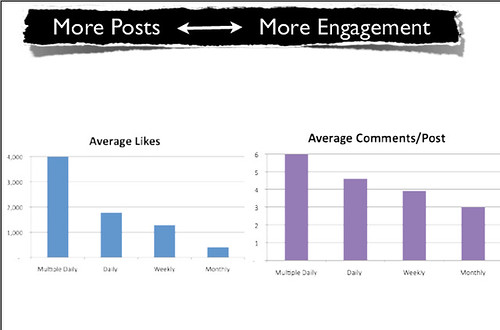I’m leading a social media peer learning project called “Leveraging Social Media: Becoming A Networked Nonprofit.” Devon Smith, who writes the 24 Usable Hours blog, and a self-described “data nerd” did a benchmarking analysis for participants.
Benchmarking is the process of comparing your organization’s practices and results with a group of peer organizations. It can be an informal study and simple to do. You identify a list of similar organizations and collect specific metrics to compare. You can gather publicly available data or do a survey with a free tool like Google Forms.
Sometimes benchmarking studies can be more rigorous and survey a field. Take for example, the NTEN Social Network 2011 Benchmarking Study or the Digital IQ Study of Government Sites.
Benchmarking, whether an informal or extensive research study, can be an incredibly valuable exercise because the numerical analysis can help you craft realistic measurable objectives. And, the process of observing even 10 other similar organizations social media practices can give you lots of good ideas if you approach with discipline.
Devon’s benchmarking study collected social media data from a survey of 2o7 arts organizations, referred by participants in Track 2. Devon summarized the data in the above presentation.
Let’s apply the benchmarking data for an arts organization that wants to be highly effective at using Facebook in the beginning stages of practice or going from crawling to walking as outlined in “Crawl, Walk, Run, Fly Model. The first step would be to identify the intent. A good early stage intent might be awareness or deepening engagement. Next, the organization would need to identify a SMART objective.
Here’s where benchmarking can be useful: identifying attainable objectives because you’re not picking a number out of the air.

If an arts organization’s intent in using Facebook was to raise brand awareness, they set a SMART objective based on the benchmarking study, specifically the metric of median network size for Facebook.
By the end of 2011, we will increase the number of people who “Like” us on Facebook to the median Facebook network or x%.

Another intent might be to generate fan conversations related to the organization’s audience art appreciation goals. They might use the benchmarking study metric of post frequency and comments per post. The SMART objective might look something like this:
By the end of Leveraging Social Media experiment, we will post content daily that engages people in our art and increases the number of comments per post by x
At a more advanced level of practice, one might do a benchmarking study and ask participants to share their lowest and highest Facebook Feedback percentage from Insights data.
Identifying a SMART objective is an essential to success, but your organization needs to measure results in context. A benchmarking process can help.
I’m going to blogging more about how networked nonprofits use measurement and use data for making decisions about improving their practice and getting results. So, I’m really interested your answers to these questions:
Does your organization benchmark its social media practices and results? How? What did you learn?

Leave a Reply